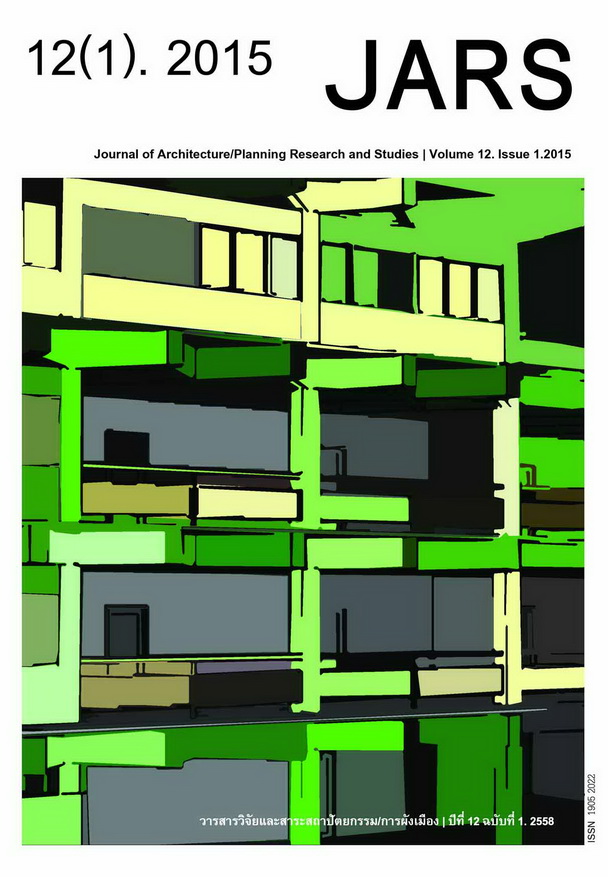Development of Support System Tools for Protect Cultural Heritage Sites from Flood Risk (PCH) Plug-in Tools
Main Article Content
Abstract
This paper demonstrates the procedure for development of a support system to protect cultural heritage from flood risk (PCH) plug-in tools in SketchUp that supports planners and designers in developing satisfactory design solutions in the conceptual design integrated with urban management and local neighborhood. As well as the outline of the support system, the results of system use the mapping for flood risk protection and urban cultural heritage in Ayutthaya. In this stage, two approaches are presented including an urban scale and local neighborhood scale which were mapping of cultural heritage distributions damage sites and neighborhood map making. To support decision maker and local people to identify more policies necessary for better living safety and awareness, protection of cultural heritage. A holistic view based on integrated flood risk assessment and cultural methods for establish a support system for the integration of spatial information from decision maker of flood risk and cultural heritage planning for multi-scale spatial planning is further.
Downloads
Article Details

This work is licensed under a Creative Commons Attribution-NonCommercial-NoDerivatives 4.0 International License.
All material is licensed under the terms of the Creative Commons Attribution 4.0 International (CC-BY-NC-ND 4.0) License, unless otherwise stated. As such, authors are free to share, copy, and redistribute the material in any medium or format. The authors must give appropriate credit, provide a link to the license, and indicate if changes were made. The authors may do so in any reasonable manner, but not in any way that suggests the licensor endorses you or your use. The authors may not use the material for commercial purposes. If the authors remix, transform, or build upon the material, they may not distribute the modified material, unless permission is obtained from JARS. Final, accepted versions of the paper may be posted on third party repositories, provided appropriate acknowledgement to the original source is clearly noted.
References
Afacan, Y. & Demirkan, H. (2011). An ontology-based universal design knowledge support system. Knowledge-Based Systems, 24(4), 530-541.
Anantsuksomsri, S. & Tontisirin, N. (2013). Review article: Agent-based modeling and disaster management.Journal of Architectural Research and Studies, 10(2), 1-14.
Birkmann, J. (2007). Risk and vulnerability indicators at different scales: Applicability, Usefulness and policy implications. Environmental Hazards, 7(1), 20-31.
Daungthima, W. & Hokao, K. (2013a). Analysing the possible physical impact of flood disaster on cultural heritage in Ayutthaya, Thailand. International Journal of Sustainable Future for Human Security J-SustaiN, 1(1), 35-39.
Daungthima, W. & Hokao, K. (2013b). Assessing the flood impacts and the cultural properties vulnerabilities in Ayutthaya, Thailand. Procedia Environmental Sciences, 17, pp. 739-748.
Jha, A. K., Bloch, R. & Lamond, J. (2012). Cities and flooding: A guide to integrated urban flood risk management for the 21st Century. Washington, DC.: World Bank.
Lai, J. S., Chang, W. Y., Chan, Y. C., Kang, S. C. & Tan, Y. C. (2011). Development of a 3D virtual environment for improving public participation: Case study – The Yuansantze Flood Diversion Works Project. Advanced Engineering Informatics, 25(2), 208-223.
Nalepa, G. J. (2010). Collective knowledge engineering with semantic wikis. Journal of Universal Computer Science, 16(7), 1006-1023.
Ozkaya, I. & Akin, O. (2006). Requirement-driven design: assistance for information traceability in design computing. Design Studies, 27(3), 381-398.
Roozenburg. N. F. M. & Eekels, J. (1994). Product design: Fundamentals and methods. Chichester: John Wiley & Sons.
Saltbones, O. A. (2006). Indonesia after the earthquake that hit Jave - May 2006. In The Johns Hopkins and the International Federation of Red Cross and Red Crescent Societies. Public health guide for emergencies. (pp. 26-43). Baltimore, MD.: Johns Hopkins University.
Schreyer, A. C. (2013). SketchUp plug-in. N.P.: n.p.
Shook, G. (1997). An Assessment of disaster risk and its management in Thailand. Disasters, 21(1), 77-88.
The United Nations office for Disaster Risk Reduction. (2013). Serving the information needs of the disaster reduction community. Retrieved March 11, 2013, from http://www.preventionweb.net
The World Bank. (2012). Thai flood 2011: Rapid assessment for resilient recovery and reconstruction Planning. Washington, DC: World Bank.


